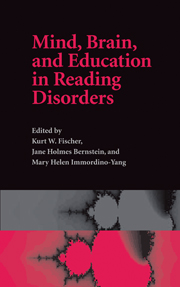Book contents
- Frontmatter
- Contents
- List of figures
- List of tables
- List of contributors
- Acknowledgements
- Part I What is Reading, and What are Reading Disorders? Looking to Neuroscience, Evolution, and Genetics
- Part II Reading and the Growing Brain: Methodology and History
- Part III Watching Children Read
- 10 Finding common ground to promote dialogue and collaboration: using case material to jointly observe children's behavior
- 11 Analyzing the reading abilities of four boys: educational implications
- 12 First impressions: What four readers can teach us
- 13 Analysis of reading disorders from a neuropsychological perspective
- 14 An educational/psychological perspective on the behaviors of three children with reading disabilities
- Part IV Reading Skills in the Long Term
- Appendix: Transcript and behavioral data from Profiles in Reading Skills (Four Boys)
- Index
- References
12 - First impressions: What four readers can teach us
Published online by Cambridge University Press: 22 September 2009
- Frontmatter
- Contents
- List of figures
- List of tables
- List of contributors
- Acknowledgements
- Part I What is Reading, and What are Reading Disorders? Looking to Neuroscience, Evolution, and Genetics
- Part II Reading and the Growing Brain: Methodology and History
- Part III Watching Children Read
- 10 Finding common ground to promote dialogue and collaboration: using case material to jointly observe children's behavior
- 11 Analyzing the reading abilities of four boys: educational implications
- 12 First impressions: What four readers can teach us
- 13 Analysis of reading disorders from a neuropsychological perspective
- 14 An educational/psychological perspective on the behaviors of three children with reading disabilities
- Part IV Reading Skills in the Long Term
- Appendix: Transcript and behavioral data from Profiles in Reading Skills (Four Boys)
- Index
- References
Summary
Overview: Watching real children read reminds us what we do and do not yet understand about the reading process, especially how little is known about the underlying processing deficits that cause dyslexic behavioral patterns. To ground this point, Blachman compares the three dyslexic readers to Jonathan, an effective reader, and stresses the relation between accuracy and fluency in the production of functional reading. While much neuropsychological research focuses on the processes underlying reading accuracy, methods to remediate poor fluency need attention in research and practice (see Wolf and Ashby, this volume). From an educational perspective, children must combine accuracy and fluency in order to improve their comprehension and their comfort with reading.
The EditorsWhat do you see when you watch four young boys read? To prepare for the conference on which this volume is based, speakers were asked, essentially, to reflect on this question. We were asked to view a videotape of four 9-year-old boys, one typical reader and three poor readers, and use the profiles of these children as the centerpiece for our remarks. The videotape was divided into two sections, each showing the children engaged in a series of diagnostic tests, and speakers were asked to respond to one section or the other. I was asked to respond to the section that included measures of rapid naming (Denckla & Rudel, 1976) and measures of isolated word reading (reading words and non-words from lists) (Test of Word Reading Efficiency, Torgesen, Wagner, & Rashotte, 1999; The Woodcock-Johnson Psycho-Educational Battery–Revised, Woodcock & Johnson, 1989).
- Type
- Chapter
- Information
- Mind, Brain, and Education in Reading Disorders , pp. 217 - 226Publisher: Cambridge University PressPrint publication year: 2007



